#romane in france
Explore tagged Tumblr posts
Text
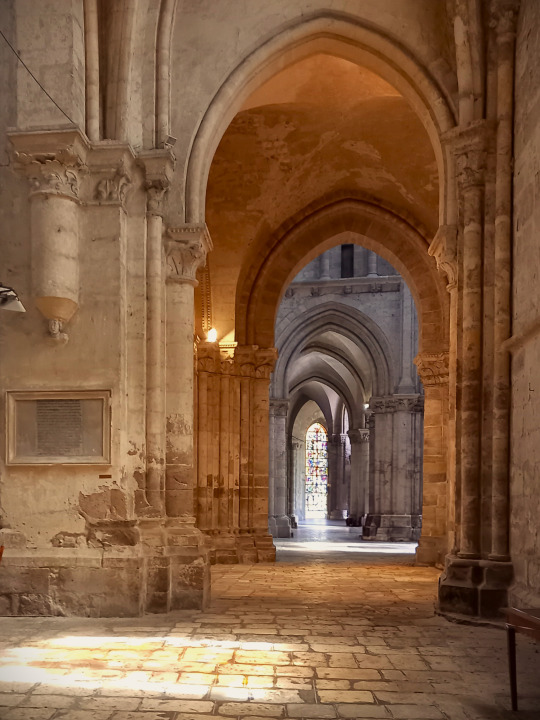
Eglise Saint-Nicolas, Blois, France
#church#architecture#middle ages#photo#mine#france#medieval#medieval art#ancient#history#religious art#cathedral#roman architecture#gothic art#gothic architecture#gold#light academia#light academic aesthetic#light academism#ancient art#europe#photos#photography#my photos#photographers on tumblr
2K notes
·
View notes
Text

Charles-Amable Lenoir (French, 1860-1926) A dance by the sea, n.d.
#different colour and quality#Charles-Amable Lenoir#French art#French#France#art#fine art#european art#classical art#europe#european#fine arts#oil painting#europa#mediterranean#a dance by the sea#1800s#female#woman#greek#roman#southern europe
1K notes
·
View notes
Text

I enjoyed the creative process
#I love this template#hetalia#hws france#hws holy roman empire#hws hre#aph france#aph holy roman empire#aph hre#chibitalia#hetameme
467 notes
·
View notes
Text


The Arena of Nîmes, France. 0ne of the best-preserved Roman amphitheatres in the world.
The construction of the building began around year 90 during the reign of Domitian (81-96) and was inaugurated in the time of Trajan (98-117)
Photos: Wolfgang Staudt (1), Kristina Dowling (2)
666 notes
·
View notes
Text

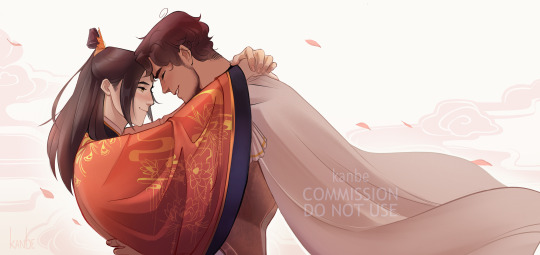





bunch of very old and not so comms I never posted for some reason but still like 😇 the more recent ones were made for @raven6229 and @frog-frussy !!! the owners of the old ones are lost in IG im afraid......
#some of them are from 2020-21 i believe#I do hope that my memory doesn`t fail me and none of the owners were against the publication atm#but IF pls contact me and I`ll remove it asap#also I'll be completely honest with you dakimakura is what I learned to draw for#its my magnum opus#it has a second side but I`ll leave it to your imagination 😋#hetalia#aph england#aph france#fruk#aph canada#aph russia#aph roman empire#aph china#aph australia
950 notes
·
View notes
Text
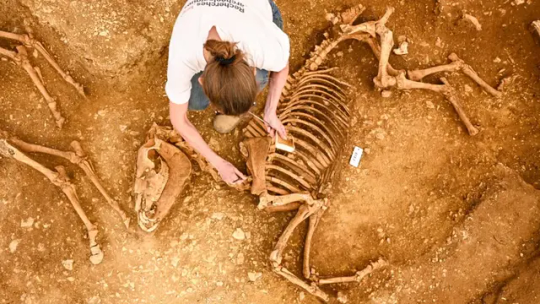
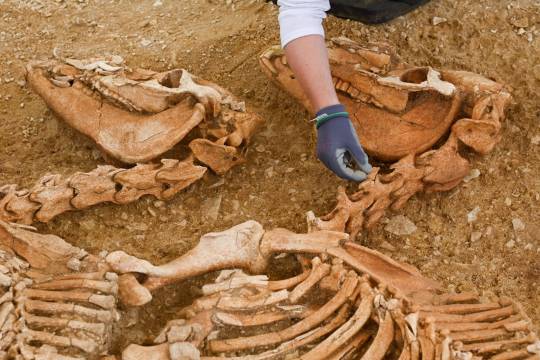
Archaeologists Uncover ‘Astonishing’ Remains of Horses Buried 2,000-Years-Ago
Archaeologists in France have uncovered nine “astonishing” graves containing the skeletons of 28 horses that were buried about 2,000 years ago, though their precise cause of death remains a mystery.
Discovered in Villedieu-sur-Indre, a commune in central France, two of the graves have been fully excavated so far, the French National Institute for Preventive Archaeological Research (INRAP) said in a statement.
The horses have been radiocarbon-dated back to somewhere between 100 BC to 100 AD.
Archaeologists found 10 complete horse skeletons in one pit and two in the other, all carefully placed in the same manner lying on their right flank with their heads to the south.
All these horses were buried at the same time shortly after their deaths, archaeologists said after observing the position of the skeletons and the connections between the bones.
Another grave is situated between these two pits but it contains two medium-sized dogs, both lying on their left side with their heads facing west.
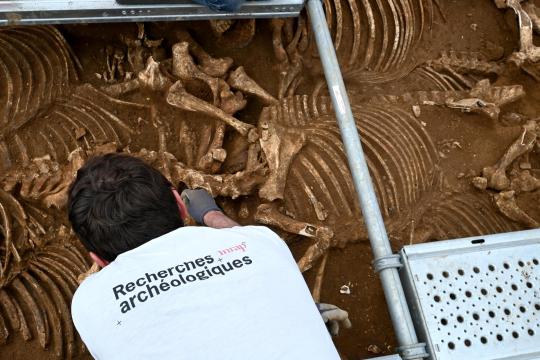

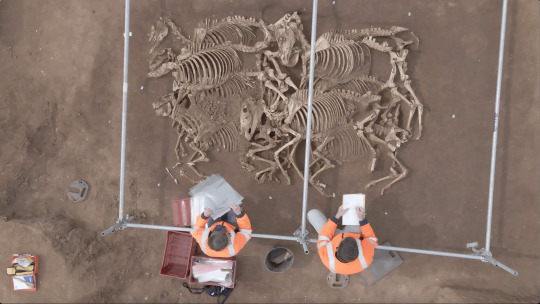
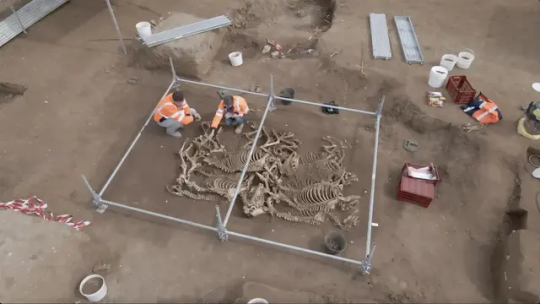
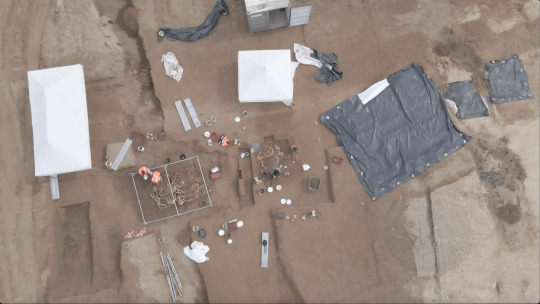
Archaeologists have yet to fully excavate the remaining graves but have already identified a total of 28 horses from the skulls and coxal bones that appear on the surface.
Killed in battle, or ritual sacrifice?
However, the horses’ precise cause of death still remains unclear.
Archaeologists have ruled out an epidemic since there are no foals or mares in these graves; all the skeletons are fully-grown stallions aged over four years old. That leaves, archaeologists said, the possibilities that these horses were either killed in battle or as part of a ritual sacrifice.
When these horses died about 2,000 years ago, there was a fortified Celtic settlement known as an oppidum just a few hundred meters away and this location mirrors that of two other similar horse burial sites that archaeologists had previously uncovered in the same region.
Due to this location, they have hypothesized that the horses’ deaths at the sites could be connected to the battles of the Gallic Wars in which Julius Caesar conquered Gaul between 58 - 50 BC.

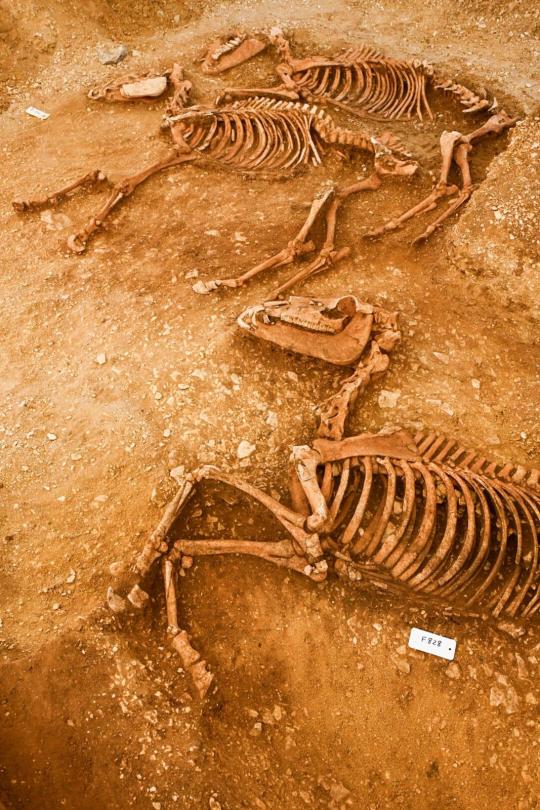
There may be another explanation, however: ritual sacrifice.
“The hypothesis that these animals were sacrificed as part of a complex ritual, of which only a few scraps remain, must also be considered,” the INRAP statement said.
If these horses were indeed buried as part of a ritual rather than killed in battle, the sheer number shows the “importance and extent of the sacrifice,” the statement added.
Other finds at the site, which sits on the slope of a valley, include buildings, pits, ditches and a road that archaeologists dated to the late 5th and early 6th centuries.
By Issy Ronald.
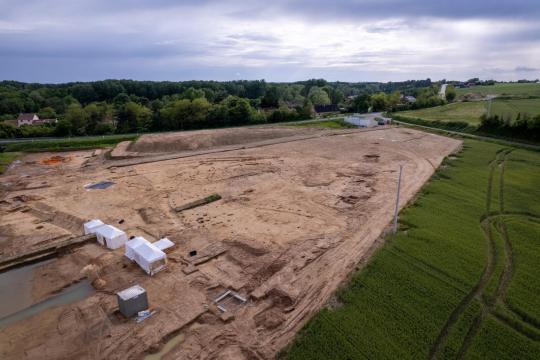
#Archaeologists Uncover ‘Astonishing’ Remains of Horses Buried 2000-Years-Ago#Villedieu-sur-Indre#France#Gallic Wars#Julius Caesar#ancient artifacts#archeology#archeolgst#history#history news#ancient history#ancient culture#ancient civilizations#roman history#roman empire
967 notes
·
View notes
Text

Charlemagne anxiously observes the approach of ships carrying Norman raiders by Alphonse de Neuville
#alphonse de neuville#art#charlemagne#normans#raiders#francia#france#paris#french#vikings#viking#franks#frankish#germanic#carolingian#history#medieval#middle ages#europe#european#viking age#mediaeval#norman#pirates#marauders#raid#holy roman empire#holy roman emperor#françois guizot#carolingian empire
299 notes
·
View notes
Text

Photo originale par Steph-Photo
Une visite à l'abbaye du Thoronet (83). Chef d'œuvre de l'art cistercien !
#original photographers#steph photo#original post#french photographer#photographers on tumblr#france#provence#leica q3#abbaye#catholic church#church#cloître#roman architecture#lumière#ombres et lumières#cistercians#cistercien#var
186 notes
·
View notes
Text
Y'all wanna know about a gender-non-conforming knight from 13th century France? No? That's okay- I'm fine with talking to myself.
I'm obsessed with gender performativity in early medieval texts- so obviously I had to know everything about Le Roman De Silence.
To preface-
So, long before there was the Marvel Cinematic Universe- there was the interconnected works of the Arthurian Legends. The original superheroes- King Arthur, Merlin, Morganna le Fey, and the rest of the cast. However, one of the lesser known (only arguably canonical) interconnected texts of the Arthurian legend hails from France. People argue over whether or not to include these texts as part of the cannon of King Arthur because it's technically french- and the french-english divide between characterization of all the main players of Arthur's court is remarkably different. Much research on this suggests the discrepancy of characterization is largely due to distance between where the stories originate, and sociopolitical tensions between the French and the English. Either people were too far apart to share stories- thus too far apart to keep characterization uniform, or they fucking hated each other enough to mess up the characterization on purpose. For example, many of the French portrayals of King Arthur paint him to be a rather terrible person, where English portrayals are generally more kind to him.
All that aside- many people will disagree that Le Roman de Silence should even be part of the Arthurian legend canon anyway- because it only mentions Merlin at the end of the poem and because it's a super french poem.
The main storyline is about this character named Silence. From the Old French Poem- Le Roman de Silence.
Gender? No- Never heard of it.
The latter half of the story in this poem is predicated on a complex mediation of Nature vs Nurture. What happens is that a baby is born into a wealthy family, and for sociopolitical reasons, the family decides to raise the girl baby as a boy. They name this child "silence." Silence grows up with full access to an education, as was typical for the boy children of aristocratic medieval families- this education becomes important later as Silence wrestle with where they fit into the larger social structure after maturing into adulthood. Essentially, they find the idea of marriage too boring and would like to be a Knight or Explorer instead. (I love them.) Anyway, it's fascinating to me that the conceptual ideas of nature and nurture are personified into being something like "deities" which are overseeing the growth of Silence through the ages- and so we get these deities commentary.
Silence wants to be a knight- so Nurture brags about being right that gender is more performative than it is biological. Then, later Silence grows up to be remarkably "pretty" and according to the deity of Nature- they brag about being right that biology and gender are intrinsically tied. It's such a thought-provoking mediation on gender as either performance or pure biology that I forget it was written in the 13th century- long before Freud or Lacan or any of the others who became hyper fixated on human presumption of gender as either a social category or a biological necessity.
I argued in a paper, once, that the narrative itself does actually finally end on the note that Gender is a performance, and it is tied into social roles only so the ruling class can have control of the population. That is why the stories ending shifts into horror-genre-esque of Silence marrying into the upper-ruling class.
I also have a strong urge to write a Fanfiction of Silence as a knight- who does not meet a sad fate but rather lives happily as a knight and eventually marries a princess. Okay- Okay? fine I said it. I said it-
Social pressure to marry?
The story takes a dark turn, however- when the King demands Silence to reveal themselves in front of the court. Obviously, even the author of the story was aware that misogynistic social standards would not allow for people to ever really be free of gender stereotypes and roles. So, Silence is then forced out of the adventurous lifestyle of a knight and into a marriage. Also, this is the place in the story where Merlin makes an appearance (I have a theory that Merlin is representative of the devil, and the author really hated that all AFAB people were forced into marriage back in 1200's. So that's why the devil shows up when all the bad shit is happening to Silence).
Inevitability and dismay-
What I find particularly interesting about this poem is the fact that the end, as Silence is forced into marriage and back into "proper" social roles for their assumed biological characteristics, is the fact that it is written like an early attempt at gothic horror!
So, one of the stipulations for something being a "gothic horror" is 1.) old, archaic, twisted buildings. (this blog is indeed named after my fixation with gothic horror elements, it's interplay relation to social reform, as its emphasis on decay as the tonal necessity for social indemnification). Anyway, the other most important aspect of gothic horror- is an overwhelming sense of desolation, isolation, and loneliness.
Sure, Silence is forced into marriage- but even with the forthright writing style of the author, we, as readers, are struck by Silence's loneliness. Thus, the "happily ever after" part of the storyline wherein the characters get married, as it traditional to chivalric romance, is recriminated against in subtext. Now, we have a moment in which the "happily ever after" is a creation of horror rather than peace.
Ending the narrative with marriage as equivalent to a loss of freedom and a sense of evermore-present loneliness, cumulating in the edifice of horror-struck fear in Silence at their own new future, is a remarkably bold social statement coming from a 13th century author.
I just think it's a really interesting text on the thematic points of negotiating Gender identity, in broader terms of performance and social roles, as much as it is a critique on the total social control that the monarchy held over the people of 13th century France.
Edit: I need to add that Silence themselves consistently rejects the idea that they are AFAB and instead only ever refers to themselves as "Silence" or "the knight"
#le roman de silence#medieval literature#13th century#manuscript#nature vs nurture#traditional gender roles#gender roles#france#french literature#french poetry#classic literature#academia#dark academia#gothic horror#marvel cinematic universe#king arthur#merlin#arthurian legend#arthurian mythology#arthurian literature#knight#medieval knight#gender#agender#nonbinary#chivalry#romantic literature#literary criticism#literary theory#poetry
287 notes
·
View notes
Text

Montmartre, Paris, France: Montmartre is a large hill in Paris's northern 18th arrondissement. It is 130 m high and gives its name to the surrounding district, part of the Right Bank. Montmartre is primarily known for its artistic history, for the white-domed Basilica of the Sacré-Cœur on its summit, and as a nightclub district. Wikipedia
#Montmartre#Sacré-Cœur#Basilica of Sacré Cœur de Montmartre#Sacred Heart of Montmartre#Minor basilica#Roman Catholic#18th arrondissement#Paris#France#europe
226 notes
·
View notes
Text
"Who's your favourite character in Hetalia?" oh the one with blonde hair and blue eyes
#ladonia stands out because he is gingering#hetalia#aph america#aph france#aph denmark#aph germany#aph finland#aph sweden#aph germania#aph ukraine#aph belarus#aph latvia#aph estonia#aph monaco#aph sealand#aph holy roman empire#hws america#hws france#hws denmark#hws germany#hws finland#hws sweden#hws germania#hws ukraine#hws belarus#hws latvia#hws estonia#hws monaco#hws sealand#hws holy roman empire
105 notes
·
View notes
Text










from the archives
#i feel like some people would appreciate having my old hetalia art available#i might post some more old stuff but idk#fanart#aph italy#aph romano#aph spain#aph france#aph england#aph russia#aph china#aph america#aph japan#aph germany#aph prussia#hetalia#aph holy roman empire#gerita
58 notes
·
View notes
Text
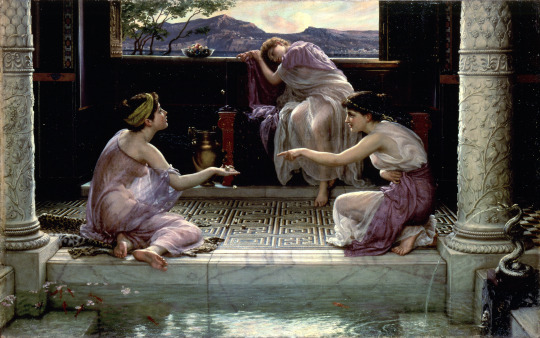
Sir Edward John Poynter (French-born British, 1836-1919) When the World was Young, 1891
#edward john poynter#french#british#1800s#when the world was young#art#classical art#fine art#european art#europe#european#fine arts#europa#mediterranean#western civilization#oil painting#women#woman#roman pool#france#arts#classical#classic#beauty#beautiful art#romanticism#genre painting#idyll
538 notes
·
View notes
Text
La Madeleine 🏛️ Paris

#Church of Sainte Marie Madeleine#La Madeleine#Roman Temple#Religious Art#Pediment#Sculpture#Church#Neoclassical#Architecture#Column#Corinthian Order#Place de la Madeleine#French Moments#Paris#France
89 notes
·
View notes
Text
I've been looking at a lot of face family fanart lately, as well as some Tomato Gang fanart. I did notice that, for the second one, there wasn't as much fanart of in the Western fandom (but there's a ton in the Japanese fandom).
That made me wonder, which Hetalia Family/Group is the favorite of the Western fandom?
#hetalia#hws#hetalia world stars#aph italy#aph germany#aph america#aph france#aph prussia#aph romano#hetalia polls#aph portugal#aph spain#aph south italy#aph baltics#aph austria#aph liechtenstein#aph lithuania#aph latvia#aph nordics#aph scotland#aph korea#aph wales#aph england#aph finland#aph sweden#aph denmark#aph norway#aph iceland#aph hre#aph holy roman empire
92 notes
·
View notes
